
Master the Art of the B2B Sales Pitch with Our 6-Step Guide
You already know this: the ability to deliver a compelling and persuasive sales pitch can make or break a deal. After all, B2B sales involve:
- Multiple stakeholders
- Long sales cycles
- A complex decision-making process
What does this mean? Your sales pitch must be informative and strategically tailored to address each prospect’s unique challenges and goals.
Delivering a successful B2B sales pitch requires first understanding your prospect's business. Then, you need to identify their pain points and demonstrate how your solution can drive value for their organization.
It requires a mix of thorough research, careful planning, and effective communication.
This guide is designed to help you master the art of the B2B sales pitch. We’ll break down the entire process into manageable steps, providing you with templates and actionable tips to craft pitches that resonate with your audience.
How to Craft a Winning Sales Pitch in 6 Simple Steps
Here is a step-wise guide to design a sales pitch for maximum conversions:
1. Understand Your Prospect
Gauging your prospect involves knowing their business, getting inside their world, understanding their challenges, and seeing how your solution can make a tangible difference. Here’s how you can go about it:
Focus on the Research and Discovery Phase
Before you think about pitching, invest time in research. In the discovery phase, you gather the essential insights to shape your approach.
Don’t just skim through the company’s website or LinkedIn profile. Dive deep into their industry, competitors, and specific business challenges.
Know the Key Activities in the Discovery Phase
- Company Background Check: Understand the company’s history, mission, and values. What are their significant milestones? What strategic shifts have they undergone recently?
- Industry Analysis: Know about the industry trends affecting your prospect. Are there any regulatory changes or emerging technologies they need to adapt to?
- Competitor Insights: Identify their main competitors and what they’re doing differently. How does your prospect stack up against them?
Master Techniques for Identifying Pain Points
Here are some techniques to uncover these critical insights:
- Surveys and Questionnaires: Directly engage with prospects through surveys that ask about their most significant challenges and what solutions they’ve tried so far.
- Social Listening: Monitor social media platforms, industry forums, and online reviews to see what your prospect’s customers say about them.
- Interviews and Conversations: Talk to key stakeholders within the company, including current clients, partners, or even employees.
- Data Analysis: Look at any available financial reports, market studies, or case studies related to the prospect. Numbers often tell a story that words cannot.
Template: Prospect Research Worksheet
To ensure your research is comprehensive and organized, you can use a worksheet to compile your findings. Here’s an example template you might use:
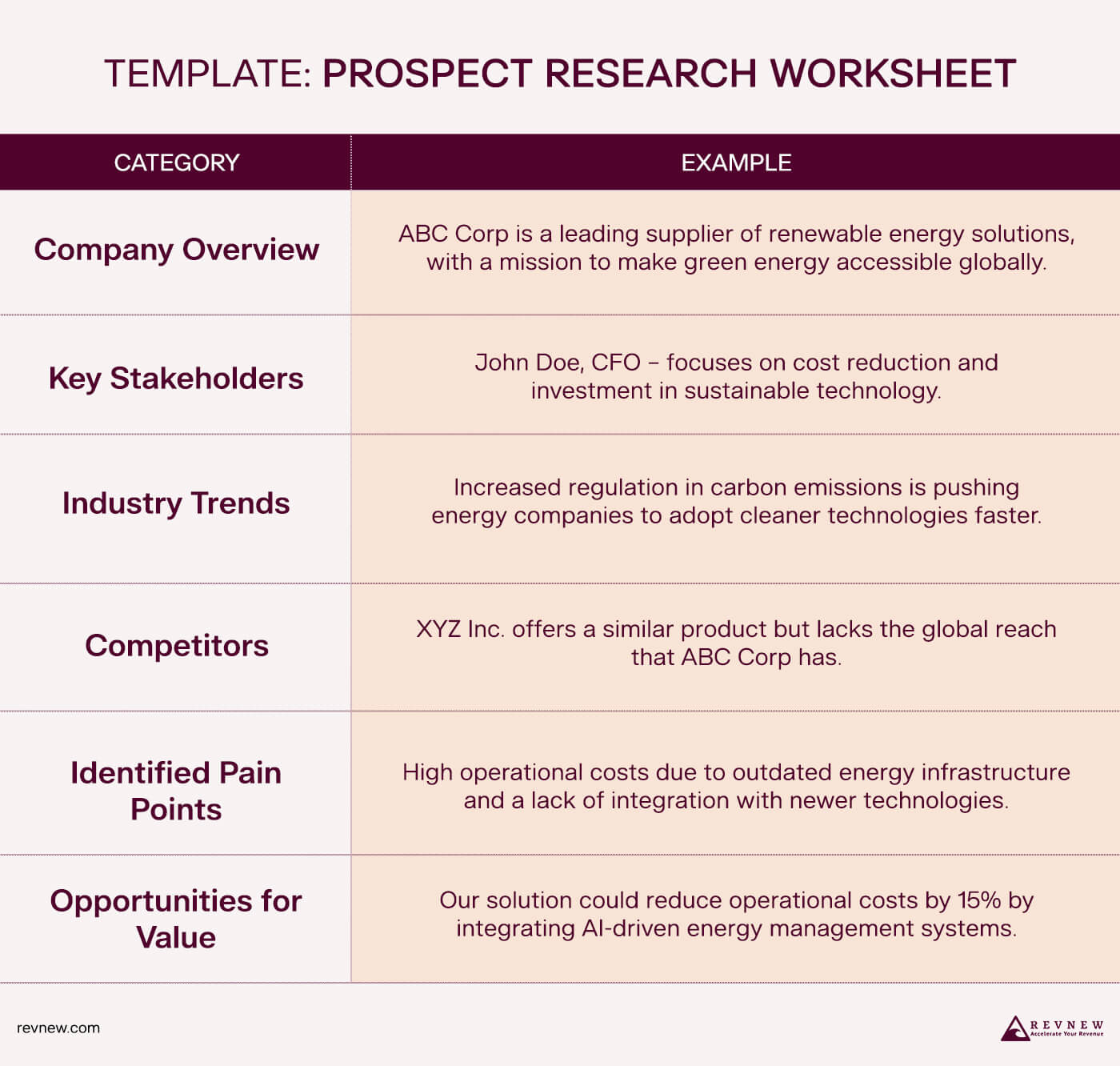
2. Craft a Tailored Value Proposition
Once you've thoroughly understood your prospect, the next step is to craft a value proposition that speaks directly to their needs.
Your value proposition must be personalized and demonstrate how your solution can address specific challenges.
Understand Unique Selling Propositions (USP)
A Unique Selling Proposition (USP) sets your product or service apart from the competition. It explains why your offer is better, different, or more effective than anything else available.
Know the Critical Elements of a Strong USP
- Clarity: Your USP must be clear and easy to understand. It should immediately convey your solution's unique benefits.
- Relevance: It should address a specific problem relevant to your prospect. It’s about solving their pain points like no other competitor can.
- Credibility: It should include claims backed by evidence, such as case studies, testimonials, or data points that validate your value proposition.
Customize the USP for Different Prospects
Each prospect is unique, so your USP should be tailored to fit each one's needs. Here’s how to customize your USP effectively:
- Segmentation: Group your prospects based on common characteristics such as industry, company size, or challenges. This will help in crafting USPs that resonate with specific segments.
- Personalization: Use the insights gathered during the research phase to tailor your USP to each prospect. Highlight the features and benefits of your solution that align most closely with their unique pain points.
- Flexible Messaging: Create a core USP that can be easily adapted depending on the audience. This flexibility allows you to emphasize different aspects of your solution based on what matters most to each prospect.
Template: USP Development Worksheet
To create a compelling USP, you can use the following worksheet template:
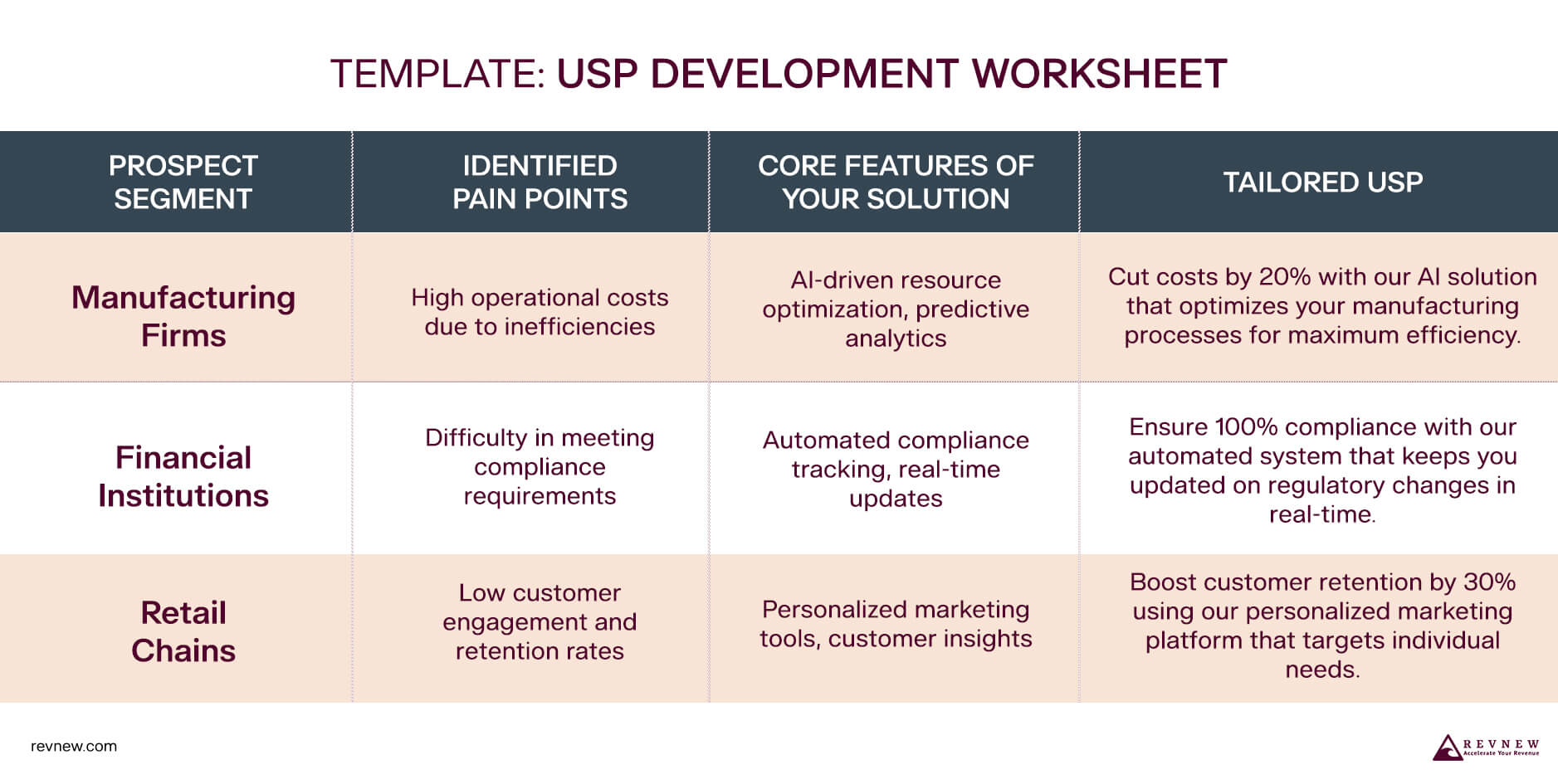
3. Structure Your Sales Pitch
A structured approach ensures your pitch is clear, persuasive, and directly aligned with your prospect's needs. Here’s a step-by-step sub-guide:
- Opening: Start with a strong opening that grabs attention. This could be a relevant statistic, an insightful question, or a brief connection-building story.
- Introduction: Introduce yourself and your company. Keep this brief but impactful, highlighting your market position or an achievement that establishes credibility.
- Problem Statement: Clearly articulate the problem your prospect is facing. Use insights from your research phase to show you understand their pain points.
- Value Proposition: Present your tailored value proposition. Explain how your solution addresses the specific challenges mentioned in the problem statement.
- Benefits and Differentiators: Highlight your solution's key benefits and what sets it apart. Focus on the outcomes that matter most to the prospect.
- Social Proof: Incorporate testimonials, case studies, or data that demonstrate the success of your solution with similar clients. This builds trust and credibility.
- Call to Action: End with a clear and compelling call to action. Whether scheduling a follow-up meeting, signing up for a trial, or moving to the next step in the sales process, make sure it’s specific and actionable.
Template: Sales Pitch Script Outline
Use the following template to draft your sales pitch script:
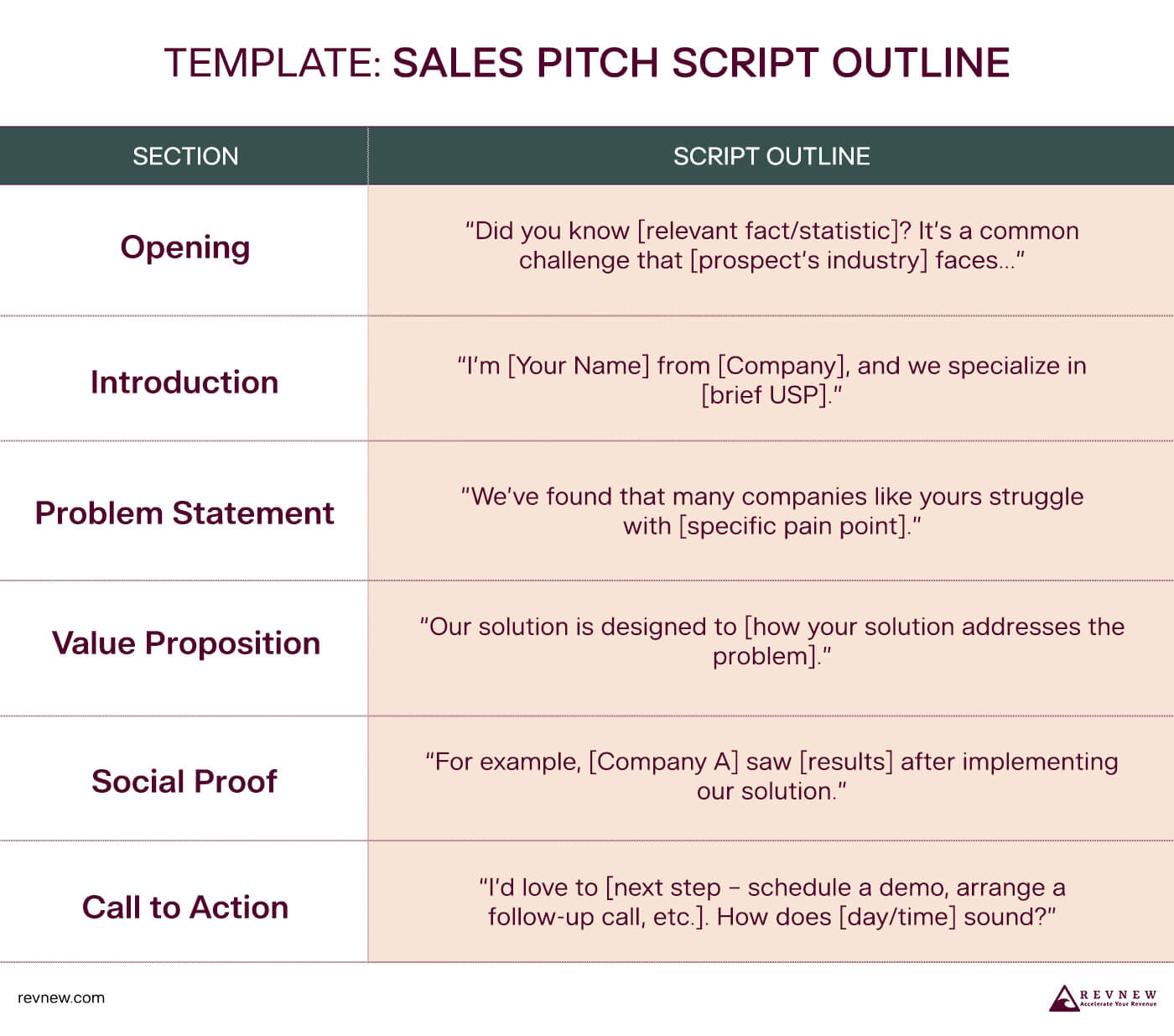
Sample Pitches for Different Scenarios
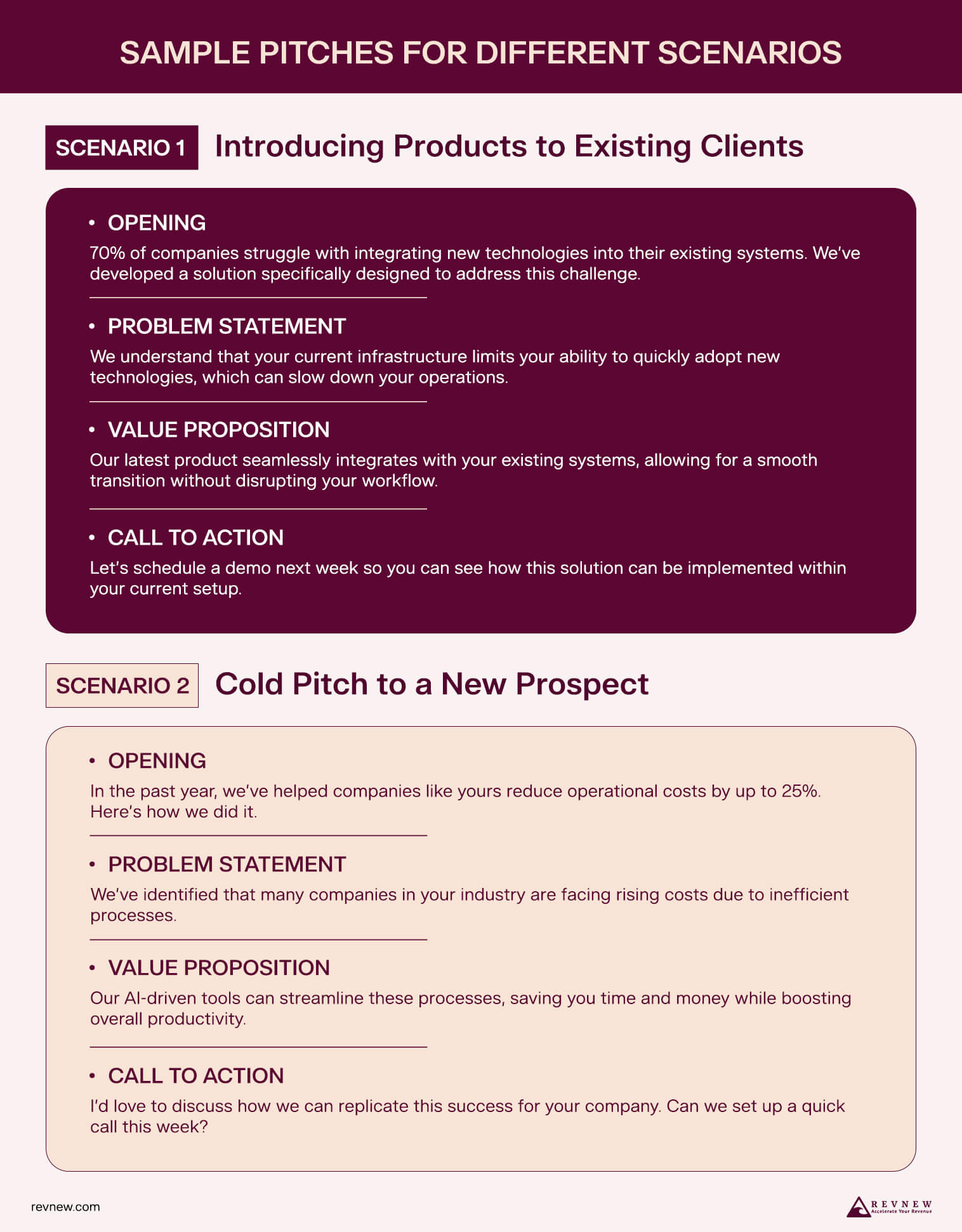
4. Deliver Your Pitch Effectively
Even the best-prepared script can fall flat if it’s not delivered confidently and clearly. Therefore,
Follow Best Practices for Pitch Delivery
- Practice: Rehearse your pitch multiple times to ensure a smooth delivery. This will help you sound natural and confident.
- Engagement: Ask questions and encourage interaction. It keeps the conversation dynamic and shows you’re genuinely interested.
- Body Language: Use positive body language, such as maintaining eye contact, nodding to show understanding, and using hand gestures to emphasize key points.
- Pace and Tone: Maintain a steady pace and vary your tone to keep the prospect engaged.
Avoid speaking too quickly, which can make it hard for the prospect to follow, or too slowly, which can cause them to lose interest.
- Adaptability: Be prepared to adapt your pitch on the fly based on the prospect’s responses. Flexibility shows that you’re listening and can meet their specific needs.
Master Techniques for Overcoming Nervousness
- Deep Breathing: Before your pitch, practice deep breathing exercises to calm your nerves. This can help lower stress levels and improve focus.
- Visualization: Visualize a successful pitch and the positive outcome you want. This mental rehearsal can boost your confidence.
- Positive Affirmations: Use positive self-talk to build confidence. Remind yourself of past successes and the value you bring to the table.
- Preparation: Knowing your material inside and out can reduce anxiety and help you handle unexpected questions or challenges.
Example Scenarios: In-Person, Virtual, and Phone Pitches
- In-Person Pitch:
- Setting: Boardroom or office setting with key decision-makers present.
- Delivery Tips: Focus on body language and direct engagement. Use handouts or visual aids to complement your pitch.
- Example: “Let me show you exactly how our solution integrates with your current systems. This chart here breaks down the process...”
- Virtual Pitch:
- Setting: Online video conferencing platform like Zoom or Teams.
- Delivery Tips: Ensure a stable internet connection, use a professional background, and position your camera at eye level.
- Example: “I’ve prepared a quick demo to walk you through the features. Let me share my screen and show you how it works.”
- Phone Pitch:
- Setting: Telephone call, often without visual aids.
- Delivery Tips: Since visual cues are absent, focus on clarity, tone, and keeping the conversation concise.
- Example: “I know you’re busy, so I’ll keep this brief. Our solution addresses the specific pain points you’ve mentioned, and I’d love to explore how we can help.”
5. Handle Objections Effectively
Objections often arise from a prospect’s uncertainty or lack of information, and addressing them effectively can turn hesitancy into agreement. Here are some common objections and strategies for addressing them:
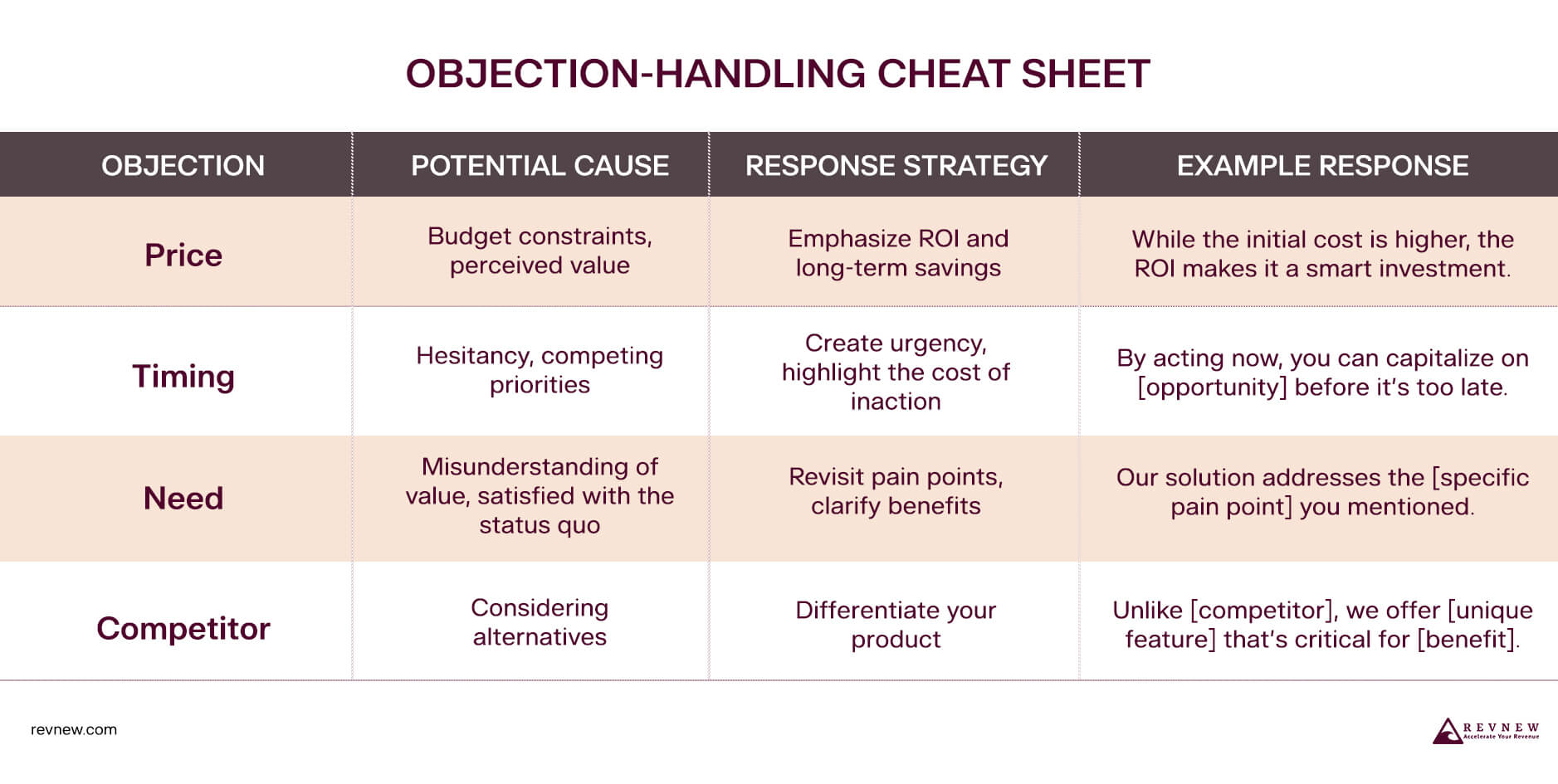
6. Close the Deal
Closing the deal is the ultimate goal of any sales process. Doing so with confidence and clarity can help secure the commitment you’ve been working towards.
Effective follow-up strategies also ensure the deal is finalized and set the stage for a strong ongoing relationship.
Close with Confidence
Here are some techniques to help you close with assurance:
- Assumptive Close: Act like the prospect has already decided to move forward. For example, “Shall we schedule the onboarding session for next week?”
- Urgency Close: Create a sense of urgency by highlighting limited-time offers or deadlines. For example, “If we move forward today, I can include the additional support package at no extra cost.”
- Question Close: Ask a question that prompts the prospect to consider the benefits of closing now. For example, “Is anything holding you back from moving forward with this today?”
- Summary Close: Summarize the benefits and agreed-upon points before requesting the final commitment. For example, “So, we’ve agreed that this solution will solve your [specific pain point] and provide [specific benefit]. Shall we finalize the agreement?”
Follow Up Promptly
Following up after your pitch and even after a verbal agreement ensures the deal is closed and the relationship is solidified. As such,
- Be Timely: To keep the momentum going, follow up within 24 hours of the initial pitch. This can be a simple thank-you note or an email summarizing the next steps.
- Personalize the Communication: Tailor your follow-up communication to your specific conversations. Mention critical points discussed and reinforce how your solution addresses their needs.
- Use Multiple Touchpoints: Don’t rely on a single follow-up. Show your dedication by using a combination of emails, phone calls, and possibly even a handwritten note.
Examples: Effective Follow-Up Emails and Calls
Follow-Up Email Example:
Subject: [Your Solution] - Next Steps
Hi [Prospect’s Name],
Thank you for taking the time to discuss [solution/product] with me today. I’m excited to help [Company Name] address [specific challenge or goal].
As we discussed, [summary of value proposition]. I’ve attached the proposal with all the details for your review.
Would you be available for a quick call later this week to finalize the details?
Looking forward to your thoughts.
Best regards,
[Your Name]
[Your Contact Information]
Follow-Up Call Example:
“Hi [Prospect’s Name], this is [Your Name] from [Company]. I wanted to check in and see if you had any questions about my proposal. I’m here to help clarify anything and discuss how we can proceed with the next steps.”
Final Word
By understanding your prospects, crafting tailored value propositions, and structuring your pitch effectively, you set yourself up for success. Handling objections confidently and closing deals with strategic follow-ups will ensure you meet your sales goals and build lasting relationships with your clients.
Now, it’s time to implement these strategies. Use the provided templates, refine your approach, and confidently step into your next pitch. The more you practice, the more natural and effective your sales conversations will become.




